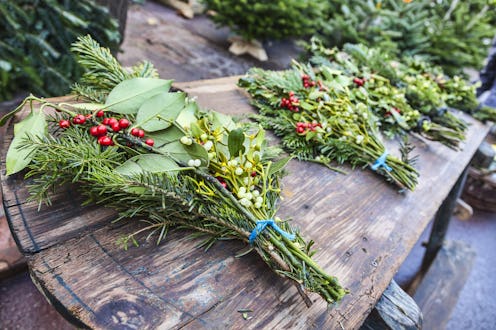
The holiday seasons are filled with tradition, some of which I've found irrelevant and outdated, and others I have found so fun that I've rarely cared how it became a tradition in the first place. Though the tradition of mistletoe is lacking the main ingredient in any kiss (consent), mistletoe's beauty benefits kind of make up for it. During the yuletide season, tiny bushels of mistletoe could be found above the door frame at holiday parties, particularly Christmas parties, and any female caught standing underneath was up for grabs. This was exactly how Screech attempted to snag a kiss from Lisa Turtle in Saved by the Bell.
Since I learned MOST of the things I know about life from Saved by the Bell, I associated mistletoe exclusively with kissing, but this decoration isn't just for Christmas and it's definitely not just for romance: Mistletoe has been considered a healing plant for over 2,000 years — much longer than it has been known as a holiday decoration. This holiday season, when I see mistletoe, I'm not anxiously looking around waiting for my creepy neighbor to plant one right on my lips. I'm looking around to make sure the coast is clear so I can put mistletoe all up on my face.
Mistletoe is a parasitic plant, but don't let the negative name fool you. This just means that the plant obtains sustenance from host plants without harming the host OR benefiting from it. Fortunately, our skin can be the host and the mistletoe will give our skin nourishment without any harm at all. Mistletoe is anti-inflammatory and has anti-aging properties, plus it's known to strengthen our immune system. It's perfect for winter skin, but also great to protect from free radicals year-round. Since mistletoe is a soothing antiseptic, it's a perfect way to fight breakouts without irritating your skin. The antioxidants give tremendous healing properties to mistletoe and makes it an ideal remedy to fight signs of aging.
If you aren't sold on the healing properties of mistletoe yet, check this out: Mistletoe has been part of numerous studies around the world suggesting mistletoe could be used to treat certain cancers. Results have been profound yet mixed, which is why John Hopkins' research team launched a multiyear study to ascertain the safety and effectiveness of mistletoe.
A little warning: You definitely don't want to start gobbling up mistletoe — it is not edible. You should also consult your physician if you are thinking of using mistletoe extract for any serious illness. However, if you are trying to get up on that DIY skincare game, mistletoe is totally safe and fairly easy to come by. You can purchase mistletoe extract at your local vitamin store for about $10.
So let's put mistletoe to good use this holiday season. Here are three skin and hair care recipes to get you started.
1. Mistletoe Anti-Aging Toner
Honestly, I went most of my life without ever using a toner, but in the last two years, I've gotten addicted to making and using toners. Since mistletoe can heal damaged skin and regenerate new skin cells, I couldn't wait to get my hands on those green leaves. The simplest way to use this toner is to boil the leaves of mistletoe in a quarter of filtered water. Use a half cup of the mistletoe tea and add two tablespoons of the water to one tablespoon of fresh aloe vera. Add a pinch of witch hazel and allow nature's healers to work their magic on a freshly washed face.
2. Mistletoe Healing Cream
This recipe is booming with holiday cheer... and unclogged pores. Use one ounce of mistletoe tea, two ounces of coconut oil, one teaspoon of beeswax, and a few drops of your favorite essential oil (I personally would recommend frankincense and sea buckthorn). Blend your ingredients together and store in a sealable jar.
3. Mistletoe Hair Treatment
Mistletoe is known to strengthen hair follicles and promote healthy growth, which means you definitely want to pour mistletoe on those dry, winter locks. To get the full benefits of the stuff, you can purchase mistletoe extract and add it into your favorite deep conditioner, or you can make mistletoe tea and use it as a hair rinse in between washes. Your slightly dirty hair will love those antiseptic properties while promoting healthy hair.
PS: Although mistletoe is safe for topical use, the leaves are the only part that need to be used for beauty remedies. The berries can be toxic and should always be kept away from children and pets.
Image: Amazon.com; Eric Meyer,
Science and Plants for Schools/Flickr; Radu Razvan/Fotolia; Giphy